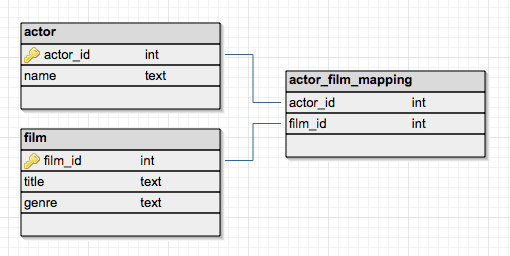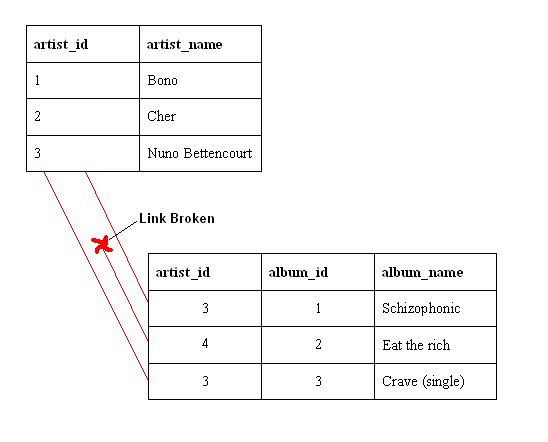|
Weak Entity
In a relational database, a weak entity is an entity that cannot be uniquely identified by its attributes alone; therefore, it must use a foreign key in conjunction with its attributes to create a primary key. The foreign key is typically a primary key of an entity it is related to. The foreign key is an attribute of the identifying (or owner, parent, or dominant) entity set. Each element in the weak entity set must have a relationship with exactly one element in the owner entity set, and therefore, the relationship cannot be a many-to-many relationship. In entity relationship diagrams (ER diagrams), a weak entity set is indicated by a bold (or double-lined) rectangle (the entity) connected by a bold (or double-lined) type arrow to a bold (or double-lined) diamond (the relationship). This type of relationship is called an ''identifying relationship'' and in IDEF1X notation it is represented by an oval entity rather than a square entity for base tables. An identifying relationship ... [...More Info...] [...Related Items...] OR: [Wikipedia] [Google] [Baidu] |
Relational Database
A relational database is a (most commonly digital) database based on the relational model of data, as proposed by E. F. Codd in 1970. A system used to maintain relational databases is a relational database management system (RDBMS). Many relational database systems are equipped with the option of using the SQL (Structured Query Language) for querying and maintaining the database. History The term "relational database" was first defined by E. F. Codd at IBM in 1970. Codd introduced the term in his research paper "A Relational Model of Data for Large Shared Data Banks". In this paper and later papers, he defined what he meant by "relational". One well-known definition of what constitutes a relational database system is composed of Codd's 12 rules. However, no commercial implementations of the relational model conform to all of Codd's rules, so the term has gradually come to describe a broader class of database systems, which at a minimum: # Present the data to the user as relati ... [...More Info...] [...Related Items...] OR: [Wikipedia] [Google] [Baidu] |
Foreign Key
A foreign key is a set of attributes in a table that refers to the primary key of another table. The foreign key links these two tables. Another way to put it: In the context of relational databases, a foreign key is a set of attributes subject to a certain kind of inclusion dependency constraints, specifically a constraint that the tuples consisting of the foreign key attributes in one relation, R, must also exist in some other (not necessarily distinct) relation, S, and furthermore that those attributes must also be a candidate key in S. In simpler words, a foreign key is a set of attributes that ''references'' a candidate key. For example, a table called TEAM may have an attribute, MEMBER_NAME, which is a foreign key referencing a candidate key, PERSON_NAME, in the PERSON table. Since MEMBER_NAME is a foreign key, any value existing as the name of a member in TEAM must also exist as a person's name in the PERSON table; in other words, every member of a TEAM is also a PERSON. ... [...More Info...] [...Related Items...] OR: [Wikipedia] [Google] [Baidu] |
Primary Key
In the relational model of databases, a primary key is a ''specific choice'' of a ''minimal'' set of attributes (Column (database), columns) that uniquely specify a tuple (Row (database), row) in a Relation (database), relation (Table (database), table). Informally, a primary key is "which attributes identify a record," and in simple cases constitute a single attribute: a unique ID. More formally, a primary key is a choice of candidate key (a minimal superkey); any other candidate key is an alternate key. A primary key may consist of real-world observables, in which case it is called a ''natural key'', while an attribute created to function as a key and not used for identification outside the database is called a ''surrogate key''. For example, for a database of people (of a given nationality), time and location of birth could be a natural key. National identification number is another example of an attribute that may be used as a natural key. History Although mainly used today in ... [...More Info...] [...Related Items...] OR: [Wikipedia] [Google] [Baidu] |
Entity Relationship Diagram
An entity is something that exists as itself, as a subject or as an object, actually or potentially, concretely or abstractly, physically or not. It need not be of material existence. In particular, abstractions and legal fictions are usually regarded as entities. In general, there is also no presumption that an entity is animate, or present. The term is broad in scope and may refer to animals; natural features such as mountains; inanimate objects such as tables; numbers or sets as symbols written on a paper; human contrivances such as laws, corporations and academic disciplines; or supernatural beings such as gods and spirits. The adjectival form is ''entitative''. Etymology The word ''entity'' is derived from the Latin ''entitas'', which in turn derives from the Latin ''ens'' meaning "being" or "existing" (compare English ''essence''). ''Entity'' may hence literally be taken to mean "thing which exists". In philosophy Ontology is the study of concepts of existence, and o ... [...More Info...] [...Related Items...] OR: [Wikipedia] [Google] [Baidu] |
IDEF1X
Integration DEFinition for information modeling (IDEF1X) is a data modeling language for the development of semantic data models. IDEF1X is used to produce a graphical information model which represents the structure and semantics of information within an environment or system.FIPS Publication 184 released of IDEF1X by the Computer Systems Laboratory of the National Institute of Standards and Technology (NIST). 21 December 1993. IDEF1X permits the construction of semantic data models which may serve to support the management of data as a resource, the integration of information systems, and the building of computer s. This standard is part of the |
Associative Entities
An associative entity is a term used in relational and entity–relationship theory. A relational database requires the implementation of a base relation (or base table) to resolve many-to-many relationships. A base relation representing this kind of entity is called, informally, an associative table. As mentioned above, associative entities are implemented in a database structure using associative tables, which are tables that can contain references to columns from the same or different database tables within the same database. An associative (or junction) table maps two or more tables together by referencing the primary keys (PK) of each data table. In effect, it contains a number of foreign keys (FK), each in a many-to-one relationship from the junction table to the individual data tables. The PK of the associative table is typically composed of the FK columns themselves. Associative tables are colloquially known under many names, including association table, bridge tab ... [...More Info...] [...Related Items...] OR: [Wikipedia] [Google] [Baidu] |
Subtype Entities , a form of type polymorphism in programming language theory
{{disambiguation ...
Subtype may refer to: * Viral subtypes, such as Subtypes of HIV * Subtyping In programming language theory, subtyping (also subtype polymorphism or inclusion polymorphism) is a form of type polymorphism in which a subtype is a datatype that is related to another datatype (the supertype) by some notion of substitutabilit ... [...More Info...] [...Related Items...] OR: [Wikipedia] [Google] [Baidu] |
Database Normalization
Database normalization or database normalisation (see spelling differences) is the process of structuring a relational database in accordance with a series of so-called normal forms in order to reduce data redundancy and improve data integrity. It was first proposed by British computer scientist Edgar F. Codd as part of his relational model. Normalization entails organizing the columns (attributes) and tables (relations) of a database to ensure that their dependencies are properly enforced by database integrity constraints. It is accomplished by applying some formal rules either by a process of ''synthesis'' (creating a new database design) or ''decomposition'' (improving an existing database design). Objectives A basic objective of the first normal form defined by Codd in 1970 was to permit data to be queried and manipulated using a "universal data sub-language" grounded in first-order logic. An example of such a language is SQL, though it is one that Codd regarded as seriou ... [...More Info...] [...Related Items...] OR: [Wikipedia] [Google] [Baidu] |
Discriminator
In distributed computing, a discriminator is a typed tag field present in OMG IDL discriminated union type and value definitions that determines which union member is selected in the current union instance. Unlike in some conventional programming languages offering support for unions, discriminator in IDL is not identical to selected field name. Here is an example of IDL union type definition: union Register switch (char) ; Effective value of the ''Register'' type may contain AX as selected field, but discriminator value may be either 'a' or 'b' and it is stored in memory separately. Therefore, IDL logically separates information about currently selected field name and union effective value from information about current discriminator value. In the example above, discriminator value may be anything of the following: 'a', 'b', 'c', as well as all other characters belonging to the IDL char type, since the default branch specified in the example ''Register'' type allows use of ... [...More Info...] [...Related Items...] OR: [Wikipedia] [Google] [Baidu] |
Referential Integrity
Referential integrity is a property of data stating that all its references are valid. In the context of relational databases, it requires that if a value of one attribute (column) of a relation (table) references a value of another attribute (either in the same or a different relation), then the referenced value must exist. For referential integrity to hold in a relational database, any column in a base table that is declared a foreign key can only contain either null values or values from a parent table's primary key or a candidate key. In other words, when a foreign key value is used it must reference a valid, existing primary key in the parent table. For instance, deleting a record that contains a value referred to by a foreign key in another table would break referential integrity. Some relational database management systems (RDBMS) can enforce referential integrity, normally either by deleting the foreign key rows as well to maintain integrity, or by returning an error and n ... [...More Info...] [...Related Items...] OR: [Wikipedia] [Google] [Baidu] |


